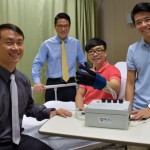 Recently I wrote about a recent project by researchers at Carnegie Mellon, who have developed a robotic prosthetic that can help its user regain their balance. It does this by working in much the same way as a human leg.
Recently I wrote about a recent project by researchers at Carnegie Mellon, who have developed a robotic prosthetic that can help its user regain their balance. It does this by working in much the same way as a human leg.
A similar project is being developed by researchers from the National University of Singapore to help people who have lost functionality in their hand.
The project, known as EsoGlove, is a lightweight rehabilitation device that aims to improve on existing robotic hand rehabilitation devices.
It contains sensors that can detect muscle signals, and the softness of the glove allows natural movement of the hand.
“For patients to restore their hand functions, they need to go through rehabilitation programmes that involve repetitive tasks such as gripping and releasing objects. These exercises are often labour intensive and are confined to clinical settings. EsoGlove is designed to enable patients to carry out rehabilitation exercises in various settings – in the hospital wards, rehabilitation centres and even at home. Equipped with technology that can detect and interpret muscle signals, EsoGlove can also assist patients in daily activities, for instance by guiding the fingers to perform tasks such as holding a cup,” the researchers say.
Subtle instruments
Until now, most robotic devices for hand rehabilitation have been clunky due to the rigid electromechnical components they contain. The EsoGlove is made up purely of soft components, and as such doesn’t require any complicated mechanical setup.
“The main body of the glove is made of fabric, with soft actuators embedded. It also has adjustable Velcro straps to cater to different hand sizes,” the team say.
Finger movements are supported by a pump valve control system that modulates the air pressure that then directs these soft actuators. When they are pressurized by air, they apply a constant force along the length of the finger, thus helping the wearer bend, extend or twist their fingers.
Understanding intent
A nice feature of the EsoGlove is its intuitive control mechanism, which involves pairing up electromyography with radio-frequency identification technologies. This allows the glove to understand the intent of the patient, and by interpreting the muscle signals of the wearer to then lend support to their efforts.
Suffice to say, the product is still a little way from market, with clinical trials due to start this month.
One product that is a little nearer to market is the RAPAEL Smart Rehabilitation device from NEOFECT. It isn’t quite as technologically advanced as EsoGlove, but does nonetheless offer users a 3D virtual space that uses games to help stroke victims recover movement.
Gloves and gaming
The smart glove users Bluetooth to empower a fully free movement, with the game environment encouraging repetitive motions to aid the physical rehab of the user.
The games encourage actions such as catching, fishing or even filling a wine glass. Whilst it utilizes games, it is in fact designed for users of all ages and aims to provide rehabilitation support to anyone recovering from strokes or central nervous disorders.
The glove connects up with the patients clinician so that they receive real-time data on the performance of the user. They can then use this feedback to adjust the difficulty of the games.
The device is currently filing for patent protection, after which a prototype will be developed. It’s a fascinating solution to what is a growing problem, and it will be great to see both innovations make it to market.
Check out the video below to find out more about RAPAEL.
That's seriously impressive. Technology really is amazing sometimes.
Look what we can do when we focus on creating! The people who did/can do this should be the giants of the modern world, not the miserable paper shufflers in banks.
This is us at our best!
Great news,keep up the good work, spend the money here rather than on arms ( and i don't mean human ones) hopefully one day the spinal cord can also be reconnected.